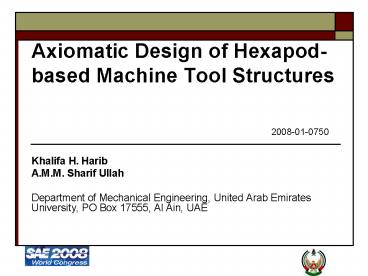Axiomatic Design of Hexapodbased Machine Tool Structures - PowerPoint PPT Presentation
1 / 17
Title:
Axiomatic Design of Hexapodbased Machine Tool Structures
Description:
Department of Mechanical Engineering, United Arab Emirates University, PO Box ... Proceedings of the Institution of Mechanical Engineers, Part I, 180(5), 371-386. ... – PowerPoint PPT presentation
Number of Views:436
Avg rating:3.0/5.0
Title: Axiomatic Design of Hexapodbased Machine Tool Structures
1
Axiomatic Design of Hexapod-based Machine Tool
Structures
2008-01-0750
- Khalifa H. Harib
- A.M.M. Sharif Ullah
- Department of Mechanical Engineering, United Arab
Emirates University, PO Box 17555, Al Ain, UAE
2
Machine Tools
Two categories of Kinematics Structures for
Machine Tools. Category One Serial Kinematics
Machine (Conventional Machine Tools)
3
Machine Tools
Category Two Parallel Kinematics Structure
(Emerging Machine Tools)
4
Machine Tools
Stewart, D. (1965). A Platform with Six Degrees
of Freedom, Proceedings of the Institution of
Mechanical Engineers, Part I, 180(5),
371-386. Stoughton, R. and Arai, T. (1993). A
Modified Stewart Platform Manipulator with
Improved Dexterity, IEEE Trans Robotics and
Automation, 9 (2), 166-173. Huang, T., Wang, J.,
Gosselin, C.M. and Whitehouse, D.J. (2000).
Kinematic Synthesis of Hexapods with Specified
Orientation Capability and Well-Conditioned
Dexterity, Journal of Manufacturing Processes, 2
(1), 36-47. Kim, S.-G. and Ryu, J. (2003). New
Dimensionally Homogeneous Jacobian Matrix
Formulation by Three End-Effector Points for
Optimal Design of Parallel Manipulators, IEEE
Trans Robotics and Automations, 19(4),
731-737. Gosselin, C. (1990). Determination of
the Workspace of 6-DOF Parallel Manipulator,
Journal of Applied Mechanical Design, 112,
331-336. Conti, J.P. Clinton, C.M., Zhang, G. and
A. J. Wavering, A.J. (1998). Workspace Variation
of a Hexapod Machine Tool, NISTIR 6135, National
Institute of Standards and Technology,
Gaithersburg, MD, March 1998.
5
Machine Tools
Wang, L.-C.T. and Hsieh, J.-H. (1998). Extreme
reaches and reachable workspace analysis of
general parallel robotic manipulators, Journal of
Robotic Systems 15(3), 145-159. Tsai, K.Y. Lee,
T.K. and Huang, K.D. (2006). Determining the
workspace boundary of 6-DOF parallel
manipulators, Robotica, 24(5), 605-611. Harib,
K.H, Ullah, A.M.M.S. and Hammami, H. (2007). A
Hexapod-Based Machine Tool with Hybrid Structure
Kinematic Analysis and Trajectory Planning,
International Journal of Machine Tools and
Manufacture, 47, 1426-1432. Mollnari-Tosatti, L.,
Fassi, I., Legnani, G. and Jovane, F. (2003).
Kineto-static Optimisation of PKMs, Annals of the
CIRP, 52(1), 337-341. Rehsteiner, F., Neugebauer,
R., Spiewak S. and Wieland, F. (1999). Putting
Parallel Kinematics Machines (PKM) to Productive
Work, Annals of the CIRP, 48(1),345-350.
6
Machine Tools
High Information Content
FR0 Design Machine Tool
Singularities Inconsistent dexterity Irregular
workspace Limited range of motion
DP0 PKM-based Structure Or DP0 SKM-based
Structure
7
Machine Tools
Condition Number of the Jacobian Matrix
determines the degree of Dexterity
Avoid Singularity, Increase Dexterity.
8
Machine Tools
Workspace ? Regularity, Volume
9
Machine Tools
Improve the following Singularities Inconsistent
dexterity Irregular workspace Limited range of
motion
10
Machine Tools
Improve the following Singularities Inconsistent
dexterity Irregular workspace Limited range of
motion
11
Axiomatic Design of 2-DOF Planar PKM
- FR1 Support an arbitrary 2-D system of forces
- FR2 Provide desired travel and well shaped
workspace boundary for axis 1 - FR3 Provide desired travel and well shaped
workspace boundary for axis 2 - DP1 Two-leg mechanism with near 90?
configuration - DP2 Strokes and average length of the first leg
- DP3 Strokes and average length of the second leg
12
Axiomatic Design of 2-DOF Planar PKM
- DP1? Two-leg mechanism with not near 90?
configuration - DP2 Strokes and average length of the first
leg - DP3 Strokes and average length of the second
leg
13
Axiomatic Design of 2-DOF Planar PKM
FR21 Provide desired x-axis travel FR22
Minimize unused space on the left and right of
the workspace DP21 Stroke of the first
leg DP22 Average length of the first leg
14
Axiomatic Design of 3-DOF Planar PKM
FR1, FR2, FR3, DP1, DP2, DP3 FR4 Support an
arbitrary planar system of torque FR5 Provide
desired angular travel DP4 Pair of parallel
legs at the central position DP5 Stroke of the
third leg
15
Axiomatic Design of 3-DOF Planar PKM
16
Axiomatic Design of 6-DOF PKM
Challenges Adaptation of CNC Program from SKM to
PKM. Calibration of PKM Structure Control
Subsystem Integration with Reconfigurable
Manufacturing Systems
17
Questions
Thank you for the attention. Questions.




























![Top 5 Machine Learning Frameworks[2020] PowerPoint PPT Presentation](https://s3.amazonaws.com/images.powershow.com/9437255.th0.jpg?_=20200508073)


